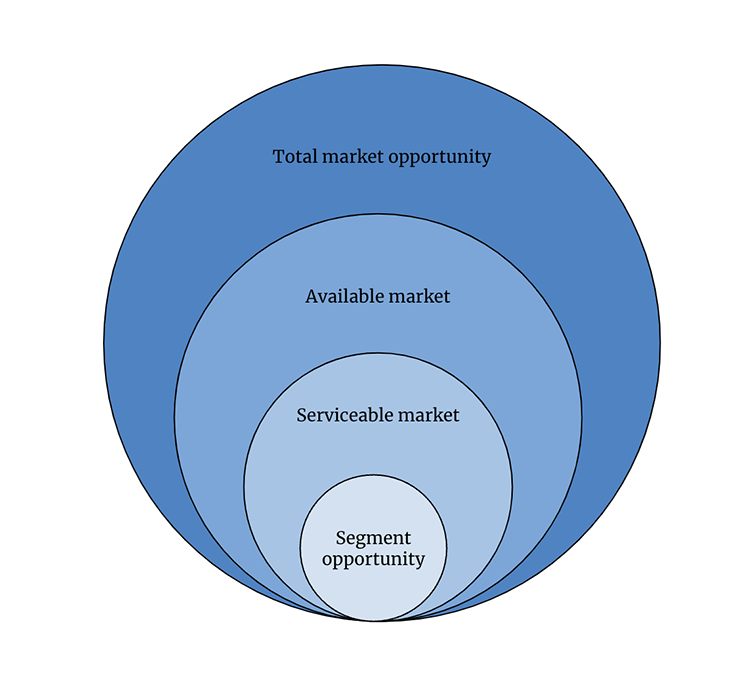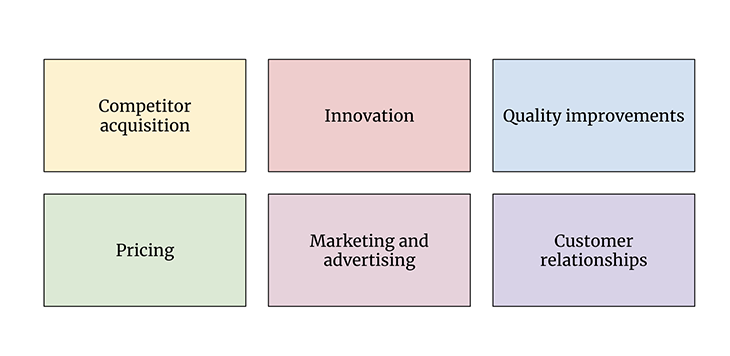It was the year 1986. This was this year that a future cult classic hit the cinemas. The movie? The Highlander. Though the movie didn’t do too well at the box office, it became a cult classic, inspiring multiple sequels and a TV spin-off.

The Highlander is a story about an immortal Scottish swordsman, Connor MacLeod, who has been battling and defeating other immortals throughout centuries. Now living in 1985, Connor finds he has to defeat the last of his kind. As the most famous quote from the movie says “There can only be one.”
Why is this the introduction to an article about market share? It is probably every startup, growing business, and well-established international corporate company’s dream to one day be the one ruling them all — having a 100 percent market share.
Fun side note, Queen created The Highlander theme “Princes of the Universe.” They also made the song “I want it all,” which I can only imagine is a song CEOs sing whilst attacking the market to increase their market share.
Let’s dive into the world of market share, understand what it is, how to calculate it, and how to grow it!
To understand the market share of a company, define the market for your product. This is so you can understand who you are competing with.
Having defined the market and competitors, sum up the total sales of all in the market over a specific period. The total sales show the market potential to go after.
Now look at your product sales in the same period, divide them by the total sales, and multiply the number by 100. Et voila, you now know the market share of the company over a specific period:

For example, if you sell 6,000,000 units over the last 12 months and the total market sales were 120,000,000 units, then your market share is:
(6,000,000 / 120,000,000) * 100 = 5%
Now that we know what the market share is and how to calculate it, why is market share important for a company? Well, it defines a lot of things about your product or company’s environment. When evaluating your market share, there are a few key things your research will unlock:

Understanding market share enables companies to understand the market potential. This is as much true for companies as for individuals in their pursuit of success. If you want to get somewhere, you need to know where you are now, define where you want to be, assess how to get there, and if it is even worth the effort.
You can imagine that a declining market is to be approached differently than a growing one.
Knowing the market share helps in defining market strategies. When you have a low market share and aim to increase it, a different market strategy will be more suitable than, say, when you’re a market leader with the biggest slice of the market pie and need to defend that.
A declining market share requires a different strategy than one that is steadily growing period over period.
Knowing is crucial to unlocking growth. Knowing your company and knowing its competitors sets you up for potential growth.
To calculate market share, you need to know the complete market. This means understanding who competitors are, calculating the market share of key competitors, and getting a better understanding of what it is that helped them take a piece of the pie. As such, it aids competitive analysis.
Comparing market share over time allows you to identify consumer behavior trends. You will have an understanding of the total market and changes, as well as shifts in your and your competitors’ market share. Diving into the details will help you answer questions such as why are customers leaving the market, why are competitors able to acquire more sales, and what are customers most interested in seeing back in the product, etc.
When you have a once-in-a-lifetime product idea that you are convinced will conquer the world, or a specific group of people that have a pain point you want to cater to, you need to validate if there even is a market. Not only that, if you are not bootstrapping, you want to convince investors to invest in your product idea. An understanding of the market potential is essential.
Before looking at the market you need to have a clear value proposition to potential customers. The value proposition describes the offering and why customers should be interested in and buy it. Having this is fundamental to establishing your market and the competitors in the market.
To calculate the market share opportunity, do market research in four steps:

Uncover the overall market size, market trends, and most interesting developments and segments.
Figure out the addressable market. This is the total market opportunity for your product. It consists of those potential customers you want to go after first because of the unique characteristic they have.
The majority of the information can be found online — but keep in mind that at times you might find contradicting, inaccurate, and confusing information. This is the fun part, as it requires you to tap into your detective skills and critically evaluate the information.
Once all the information is gathered, segment and quantify the market. This can be done by a variety of variables, including but not limited to pricing and revenue.
Are you still going strong? Great, time to look at the available market! The available market is the part of the market for which you can realistically compete.
Define potential customers covering the total available market and apply key gating factors to calculate the total number of them.
Knowing the available market, there might be constraints to servicing them all. For instance, a geographical region is unsuitable for your product because of legislation. Filtering those out will leave you with the total serviceable market.
Now, don’t we all long for instant gratification? When it comes to market share, this means understanding the part of the serviceable market that can be captured in the short term.
Calculate the number of innovators, early adopters, and part of the mainstream adopters that you can realistically convert to customers in the short term. You now know your potential initial market share opportunity.
If you are looking to acquire funding, mention the factors that need to be in place and by when to have the product adopted by this group. Outlining this information allows you to show the required investment and resources needed to grow revenue and capture the market share.
Include marketing, sales, and distribution efforts and a proposal for operational efficiency and scale.
“With a rebel yell, more, more, more” is what Billy Idol would say (or Scooter if you like the remake better).
So how do you gain and grow your market share? There are multiple options that work well hand-in-hand:

This is “pretty straightforward” — let’s put it between quotations, as a successful acquisition is a discipline in itself. Though complicated, acquiring a competitor is a sure shot (no Beastie Boys reference intended, but I’ll take it). It increases market share and at the same time reduces competition.
Gaining a competitive advantage helps grow market share. One way of doing this is through innovation. This can be through product innovation or introducing something your competitors simply haven’t yet, just to highlight two.
Further on fewer — three words that lean experts and product managers are very familiar with. By improving the quality of the product, customers are more likely to become beginning users, regulars, and or advocates.
Improving quality can revolve around the effort needed to complete a specific action, which can be measured using the customer effort score (CES) and the overall performance of the product.
Not that this is always a great strategy…it can impact how the product brand is perceived. The general rule though is that lowering price allows for attracting more customers, which increases sales and market share.
Being there where your customer needs you to be. This is not only limited to the existing customer base, but also those that fit your ideal customer profile. Personalized and dedicated marketing and advertising activities are a great way to gain market share.
If they hear of you and are ongoingly made aware of your existence, there is a higher chance they remember or even engage with you.
Churn is a horrible horrible thing. To avoid churn and losing customers to competitors, building long-lasting customer relationships is key. If the relationship is smooth, predictable, and meets expectations, there is no reason for customers to churn.
By now we have covered how to define your market and gain and grow your market share. This might be a good time to dive a little deeper into how to understand what your competitive landscape looks like.
As you have already defined the market, identify those customers who are most likely eager and willing to buy your product. Distinguish between buyers and user profiles and capture their traits using personas. Personas are fictional characters representing the different customer types that might use your product
Having clear what your product is, the market, and who it targets, you are well positioned to identify and analyze who your competitors are. You do this by conducting a competitive analysis.
The competitive analysis is an assessment of your competition’s offerings, strategy, strengths, and weaknesses.
Let’s have a look at the streaming music industry and Spotify’s market share. According to a Forbes article in April 2022, Spotify commanded 31 percent of the streaming audio services market in Q1 2022.
Conveniently, the article also mentions that Apple Music captured 15 percent of the market in the same period. A bit of Googling shows that other key competitors are Amazon Music, Tencent music, YouTube, and Deezer, capturing 13, 13, 8, and 2 percent of the market, respectively. This means that 18 percent of the market share is captured by other companies.
Presenting this information in a chart graph, it looks like this:

Market share helps you understand the position of your product in the market, and who you are competing with. For a new product, it enables you to better understand the market opportunity and possibility to gain market share. For existing products, it helps you to create your strategy on what to do next.
Featured image source: IconScout

LogRocket identifies friction points in the user experience so you can make informed decisions about product and design changes that must happen to hit your goals.
With LogRocket, you can understand the scope of the issues affecting your product and prioritize the changes that need to be made. LogRocket simplifies workflows by allowing Engineering, Product, UX, and Design teams to work from the same data as you, eliminating any confusion about what needs to be done.
Get your teams on the same page — try LogRocket today.

Most teams fail at autonomy. Learn how clear rules help product teams move faster without micromanagement.

A practical framework for PMs to use AI in ideation without sacrificing judgment, strategy, or decision quality.

A practical five minute revenue estimation method to help product managers compare ideas, drop low impact features, and prioritize smarter.

A practical guide for PMs who want to stop being bottlenecks, delegate smarter, and lead teams effectively with a clear ownership framework.